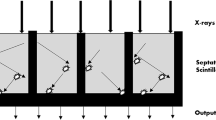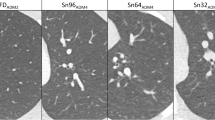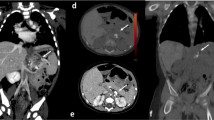Abstract
Introduction
Chest computed tomography (CT) examinations are performed routinely in some cystic fibrosis (CF) centers in order to evaluate lung disease progression in CF patients. Continuous CT technological advancement in theory could allows a lower radiation exposure of CF patients during chest CT examinations without an image quality reduction, and this could become increasingly important over time in order to reduce the cumulative radiation dose effects given the continuous increase of CF patients predicted median survival.
Objective
The aim of this study was to compare objective and subjective image quality and radiation dose between low-dose chest CT examinations performed in adult CF patients using a third-generation DSCT scanner and a 64-slices single-source CT (SSCT) scanner.
Materials and methods
Between January 2016 and August 2019, 81 CF patients underwent low-dose chest CT examinations using both a 64-slices SSCT scanner (2016–2017) and a third-generation DSCT scanner (2018–2019). Objective image noise standard deviation (INSD), signal-to-noise ratio (SNR), contrast-to-noise ratio (CNR), overall subjective image quality (OSIQ), subjective image noise (SIN), subjective evaluation of streaking artifacts (SA), movement artifacts (MA) and edge resolution (ER), dose-length product (DLP), volume computed tomography dose index (CTDIvol) and effective radiation dose (ERD) were compared between DSCT and SSCT examinations. DSCT examinations consisted in spiral inspiratory end expiratory acquisitions. SSCT examinations consisted in spiral inspiratory acquisitions and five axial expiratory ones.
Results
DSCT protocol showed statistically significant lower spiral inspiratory phase mean DLP, CTDIvol and ERD than SSCT protocol, with a 25% DLP, CTDIvol and ERD reduction. DSCT protocol showed statistically significant higher overall (inspiratory and expiratory phases) mean DLP, CTDIvol and ERD than SSCT protocol, with a 40% DLP, CTDIvol and ERD increase. Objective image quality (INSD, SNR and CNR) and SIN differences were not statistically significant, but subjective evaluation of DSCT images showed statistically significant better OSIQ and ER, as well as statistically significant lower SA and MA with respect to SSCT images.
Conclusions
To our knowledge, this is the first study evaluating chest CT image quality and radiation dose in adult CF patients using a third-generation DSCT scanner, and it showed that technological advancements could be used in order to reduce radiation exposure of volumetric examinations. The spiral inspiratory dose reduction can be obtained with concomitant improvements in subjective image quality with comparable objective quality. This will probably allow a wider use of this imaging modality in order to assess bronchiectasis and will probably foster spiral expiratory acquisition for small airways disease evaluation.




Similar content being viewed by others
References
Elborn JS (2016) Cystic fibrosis. Lancet 388:2519–2531
Palomaki GE, FitzSimmons SC, Haddow JE (2004) Clinical sensitivity of prenatal screening for cystic fibrosis via CFTR carrier testing in a United States panethnic population. Genet Med 6:405–414
Villanueva G, Marceniuk G, Murphy MS, Walshaw M, Cosulich R (2017) Diagnosis and management of cystic fibrosis: summary of NICE guidance. BMJ 359:j4574
Orenti A, Zolin A, Naehrlich L et al (2018) ECFSPR Annual Report 2016. https://www.ecfs.eu/. Accessed 1 Jan 2019
Cystic Fibrosis Foundation (2018) Cystic Fibrosis Foundation Patient Registry2017 Annual Data Report. Bethesda, Maryland. https://www.cff.org/Research/Researcher-Resources/Patient-Registry/. Accessed 1 Jan 2019
Semple T, Calder A, Owens CM, Padley S (2017) Current and future approaches to large airways imaging in adults and children. Clin Radiol 72:356–374
Wielpütz MO, Eichinger M, Biederer J et al (2016) Imaging of cystic fibrosis lung disease and clinical interpretation. Rofo 188:834–845
Castellani C, Duff AJA, Bell SC et al (2018) ECFS best practice guidelines: the 2018 revision. J Cyst Fibros 17:153–178
Tiddens HA, Stick SM, Davis S (2014) Multi-modality monitoring of cystic fibrosis lung disease: the role of chest computed tomography. Paediatr Respir Rev 15:92–97
Tiddens HA, Rosenow T (2014) What did we learn from two decades of chest computed tomography in cystic fibrosis? Pediatr Radiol 44:1490–1495
Kuo W, Ciet P, Tiddens HA, Zhang W, Guillerman RP, van Straten M (2014) Monitoring cystic fibrosis lung disease by computed tomography. Radiation risk in perspective. Am J Respir Crit Care Med 189:1328–1336
Sasihuseyinoglu AS, Altıntaş DU, Soyupak S, Dogruel D, Yılmaz M, Serbes M et al (2019) Evaluation of high-resolution computed tomography findings of cystic fibrosis. Korean J Intern Med 34:335–343
Mastellari P, Biggi S, Lombardi A et al (2005) Correlation between HRCT and pulmonary functional tests in cystic fibrosis. Radiol Med 110:325–333
Calder AD, Bush A, Brody AS, Owens CM (2014) Scoring of chest CT in children with cystic fibrosis: state of the art. Pediatr Radiol 44:1496–1506
Cademartiri F, Luccichenti G, Palumbo AA et al (2008) Predictive value of chest CT in patients with cystic fibrosis: a single-center 10-year experience. AJR Am J Roentgenol 190:1475–1480
Rybacka A, Goździk-Spychalska J, Rybacki A, Piorunek T, Batura-Gabryel H, Karmelita-Katulska K (2018) Congruence between pulmonary function and computed tomography imaging assessment of cystic fibrosis severity. AdvExp Med Biol 1114:67–76
Murphy KP, Maher MM, O’Connor OJ (2016) Imaging of cystic fibrosis and pediatric bronchiectasis. AJR Am J Roentgenol 206:448–454
Eichinger M, Heussel CP, Kauczor HU, Tiddens H, Puderbach M (2010) Computed tomography and magnetic resonance imaging in cystic fibrosis lung disease. J Magn Reson Imaging 32:1370–1378
Flohr TG, McCollough CH, Bruder H et al (2006) First performance evaluation of a dual-source CT (DSCT) system. Eur Radiol 16:256–268
Brody AS, Klein JS, Molina PL, Quan J, Bean JA, Wilmott RW (2004) High-resolution computed tomography in young patients with cystic fibrosis: distribution of abnormalities and correlation with pulmonary function tests. J Pediatr 145:32–38
Bongartz G, Golding S, Jurik AG et al (1999) European guidelines on quality criteria for computed tomography. Report EUR 16262 1999.https://www.drs.dk/guidelines/ct/quality/htmlindex.htm. Accessed 1 Jan 2019
Bongartz G, Jurik AG, Leonardi M et al (2004) European guidelines for multislice computedtomography. https://biophysicssite.com/html/msct_quality_criteria_2004.html. Accessed 1 Jan 2019
Deak PD, Smal Y, Kalender WA (2010) Multisection CT protocols: sex- and age-specific conversion factors used to determine effective dose from dose-length product. Radiology 257:158–166
Szczesniak R, Turkovic L, Andrinopoulou ER, Tiddens HAWM (2017) Chest imaging in cystic fibrosis studies: what counts, and can be counted? J Cyst Fibros 16:175–185
Loeve M, Krestin GP, Rosenfeld M, de Bruijne M, Stick SM, Tiddens HA (2013) Chest computed tomography: a validated surrogate endpoint of cystic fibrosis lung disease? Eur Respir J 42:844–857
de González AB, Kim KP, Samet JM (2007) Radiation-induced cancer risk from annual computed tomography for patients with cystic fibrosis. Am J RespirCrit Care Med 176:970–973
Deák Z, Grimm JM, Treitl M et al (2013) Filtered back projection, adaptive statistical iterative reconstruction, and a model-based iterative reconstruction in abdominal CT: an experimental clinical study. Radiology 266:197–206
Ferris H, Twomey M, Moloney F et al (2016) Computed tomography dose optimisation in cystic fibrosis: a review. World J Radiol 8:331–841
Yanagawa M, Hata A, Honda O et al (2018) Subjective and objective comparisons of image quality between ultra-high-resolution CT and conventional area detector CT in phantoms and cadaveric human lungs. Eur Radiol 28:5060–5068
Hassani C, Ronco A, Prosper AE, Dissanayake S, Cen SY, Lee C (2018) Forward-projected model-based iterative reconstruction in screening low-dose chest CT: comparison with adaptive iterative dose reduction 3D. AJR Am J Roentgenol 211:548–556
Moloney F, James K, Twomey M et al (2019) Low-dose CT imaging of the acute abdomen using model-based iterative reconstruction: a prospective study. Emerg Radiol 26:169–177
Ernst CW, Basten IA, Ilsen B et al (2014) Pulmonary disease in cystic fibrosis: assessment with chest CT at chest radiography dose levels. Radiology 273:597–605
Lin S, Lin M, Lau KK (2019) Image quality comparison between model-based iterative reconstruction and adaptive statistical iterative reconstruction chest computed tomography in cystic fibrosis patients. J Med Imaging Radiat Oncol 63:602–609
Kahn J, Kaul D, Grupp U et al (2017) Computed tomography in cystic fibrosis: combining low-dose techniques and iterative reconstruction. J Comput Assist Tomogr 41:668–674
Yel I, Martin SS, Wichmann JL et al (2019) Evaluation of radiation dose and image quality using high-pitch 70-kV chest CT in immunosuppressed patients. Rofo 191:122–129
Author information
Authors and Affiliations
Corresponding author
Ethics declarations
Conflict of interest
The authors declared no potential conflicts of interests associated with this study.
Ethical standards
All procedures performed in studies involving human participants were in accordance with the ethical standards of the institutional and/or national research committee and with the 1964 declaration of HELSINKI and its later amendments or comparable ethical standards. Informed consent was obtained from all individual participants (or their parental guardian) included in the study.
Additional information
Publisher's Note
Springer Nature remains neutral with regard to jurisdictional claims in published maps and institutional affiliations.
Rights and permissions
About this article
Cite this article
Tagliati, C., Lanza, C., Pieroni, G. et al. Ultra-low-dose chest CT in adult patients with cystic fibrosis using a third-generation dual-source CT scanner. Radiol med 126, 544–552 (2021). https://doi.org/10.1007/s11547-020-01304-w
Received:
Accepted:
Published:
Issue Date:
DOI: https://doi.org/10.1007/s11547-020-01304-w




